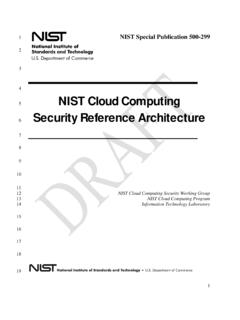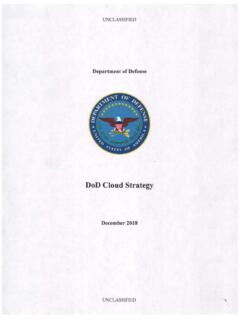Transcription of ARCHIVED: AWS Well-Architected Framework
1 ArchivedAWS Well-Architected FrameworkJuly 2020 This whitepaper describes the AWS Well-Architected Framework . It provides guidance to help cus-tomers apply best practices in the design, delivery, and maintenance of AWS environments. We addressgeneral design principles as well as specific best practices and guidance in five conceptual areas thatwe define as the pillars of the Well-Architected paper has been latest version is available at: Well-Architected FrameworkNoticesCustomers are responsible for making their own independent assessment of the in-formation in this document. This document: (a) is for informational purposes only, (b)represents current AWS product offerings and practices, which are subject to changewithout notice, and (c) does not create any commitments or assurances from AWSand its affiliates, suppliers or licensors. AWS products or services are provided as is without warranties, representations, or conditions of any kind, whether express orimplied.
2 The responsibilities and liabilities of AWS to its customers are controlled byAWS agreements, and this document is not part of, nor does it modify, any agreementbetween AWS and its customers. Copyright 2020 Amazon Web Services, Inc. or its affiliatesArchivedAWS Well-Architected FrameworkIntroduction .. 1 Definitions .. 2On Architecture .. 3 General Design Principles .. 5 The Five Pillars of the Framework .. 6 Operational Excellence .. 6 Security .. 15 Reliability .. 22 Performance Efficiency .. 28 Cost Optimization .. 36 The Review Process .. 43 Conclusion .. 45 Contributors .. 46 Further Reading .. 47 Document Revisions .. 48 Appendix: Questions and Best Practices .. 49 Operational Excellence .. 49 Security .. 60 Reliability .. 69 Performance Efficiency .. 80 Cost Optimization .. 88iiiArchivedAWS Well-Architected FrameworkIntroductionThe AWS Well-Architected Framework helps you understand the pros and cons of de-cisions you make while building systems on AWS.
3 By using the Framework you willlearn architectural best practices for designing and operating reliable, secure, effi-cient, and cost-effective systems in the cloud . It provides a way for you to consistentlymeasure your architectures against best practices and identify areas for process for reviewing an architecture is a constructive conversation about archi-tectural decisions, and is not an audit mechanism. We believe that having well -archi-tected systems greatly increases the likelihood of business Solutions Architects have years of experience architecting solutions across a widevariety of business verticals and use cases. We have helped design and review thou-sands of customers architectures on AWS. From this experience, we have identifiedbest practices and core strategies for architecting systems in the AWS Well-Architected Framework documents a set of foundational questionsthat allow you to understand if a specific architecture aligns well with cloud bestpractices.
4 The Framework provides a consistent approach to evaluating systemsagainst the qualities you expect from modern cloud -based systems, and the remedi-ation that would be required to achieve those qualities. As AWS continues to evolve,and we continue to learn more from working with our customers, we will continue torefine the definition of Framework is intended for those in technology roles, such as chief technology of-ficers (CTOs), architects, developers, and operations team members. It describes AWSbest practices and strategies to use when designing and operating a cloud workload,and provides links to further implementation details and architectural patterns. Formore information, see the AWS Well-Architected also provides a service for reviewing your workloads at no charge. The AWSWell- architected Tool (AWS WA Tool) is a service in the cloud that provides a consis-tent process for you to review and measure your architecture using the AWS well -Ar-chitected Framework .
5 The AWS WA Tool provides recommendations for making yourworkloads more reliable, secure, efficient, and help you apply best practices, we have created AWS Well-Architected Labs, whichprovides you with a repository of code and documentation to give you hands-on ex-perience implementing best practices. We also have teamed up with select AWS Part-ner Network (APN) Partners, who are members of the AWS Well-Architected Partnerprogram. These APN Partners have deep AWS knowledge, and can help you reviewand improve your Well-Architected FrameworkDefinitionsEvery day, experts at AWS assist customers in architecting systems to take advantageof best practices in the cloud . We work with you on making architectural trade-offsas your designs evolve. As you deploy these systems into live environments, we learnhow well these systems perform and the consequences of those on what we have learned, we have created the AWS Well-Architected Frame-work, which provides a consistent set of best practices for customers and partners toevaluate architectures, and provides a set of questions you can use to evaluate howwell an architecture is aligned to AWS best AWS Well-Architected Framework is based on five pillars operational excel-lence, security, reliability, performance efficiency, and cost 1.
6 The pillars of the AWS Well-Architected FrameworkNameDescriptionOperational ExcellenceThe ability to support development and run workloadseffectively, gain insight into their operations, and tocontinuously improve supporting processes and proce-dures to deliver business security pillar encompasses the ability to protectdata, systems, and assets to take advantage of cloudtechnologies to improve your reliability pillar encompasses the ability of a work-load to perform its intended function correctly and con-sistently when it s expected to. This includes the abilityto operate and test the workload through its total life-cycle. This paper provides in-depth, best practice guid-ance for implementing reliable workloads on EfficiencyThe ability to use computing resources efficiently tomeet system requirements, and to maintain that effi-ciency as demand changes and technologies OptimizationThe ability to run systems to deliver business value atthe lowest price the AWS Well-Architected Framework , we use these terms: A component is the code, configuration, and AWS Resources that together deliveragainst a requirement.
7 A component is often the unit of technical ownership, and isdecoupled from other Well-Architected Framework The term workload is used to identify a set of components that together deliverbusiness value. A workload is usually the level of detail that business and technolo-gy leaders communicate about. We think about architecture as being how components work together in a work-load. How components communicate and interact is often the focus of architecturediagrams. Milestones mark key changes in your architecture as it evolves throughout theproduct lifecycle (design, testing, go live, and in production). Within an organization the technology portfolio is the collection of workloads thatare required for the business to architecting workloads, you make trade-offs between pillars based on yourbusiness context. These business decisions can drive your engineering priorities.
8 Youmight optimize to reduce cost at the expense of reliability in development environ-ments, or, for mission-critical solutions, you might optimize reliability with increasedcosts. In ecommerce solutions, performance can affect revenue and customer propen-sity to buy. Security and operational excellence are generally not traded-off againstthe other ArchitectureIn on-premises environments, customers often have a central team for technology ar-chitecture that acts as an overlay to other product or feature teams to ensure they arefollowing best practice. Technology architecture teams typically include a set of rolessuch as: Technical Architect (infrastructure), Solutions Architect (software), Data Ar-chitect, Networking Architect, and Security Architect. Often these teams use TOGAFor the Zachman Framework as part of an enterprise architecture AWS, we prefer to distribute capabilities into teams rather than having a central-ized team with that capability.
9 There are risks when you choose to distribute decisionmaking authority, for example, ensure that teams are meeting internal standards. Wemitigate these risks in two ways. First, we have practices 1 that focus on enabling eachteam to have that capability, and we put in place experts who ensure that teams raisethe bar on the standards they need to meet. Second, we implement mechanisms 2that carry out automated checks to ensure standards are being met. This distributedapproach is supported by the Amazon leadership principles, and establishes a culture1 Ways of doing things, process, standards, and accepted Good intentions never work, you need good mechanisms to make anything happen Jeff Bezos. Thismeans replacing humans best efforts with mechanisms (often automated) that check for compliance withrules or Well-Architected Frameworkacross all roles that works back 3 from the customer.
10 Customer-obsessed teams buildproducts in response to a customer architecture, this means that we expect every team to have the capability to cre-ate architectures and to follow best practices. To help new teams gain these capa-bilities or existing teams to raise their bar, we enable access to a virtual communi-ty of principal engineers who can review their designs and help them understandwhat AWS best practices are. The principal engineering community works to makebest practices visible and accessible. One way they do this, for example, is throughlunchtime talks that focus on applying best practices to real examples. These talks arerecorded and can be used as part of onboarding materials for new team best practices emerge from our experience running thousands of systems at in-ternet scale. We prefer to use data to define best practice, but we also use subjectmatter experts, like principal engineers, to set them.















